The Real Lives of Roman Gladiators
Roman gladiators are some of the most iconic characters in history and have defined how we think of entertainment in ancient Rome. Their portrayal in films and stories has turned them into archetypal legends – facing death on a daily basis is certainly not something to be taken lightly! The Roman gladiators’ tales are incomparable to anything we see or do today, making them fascinating and yet incomprehensible.
Origins of the Gladiator Games
We tend to associate gladiators with blood, gore and brutality , but is that the real history behind these characters? We wanted to explore more to learn what ‘being a gladiator’ was really like.
The term gladiator is derived from the Latin gladiatores, in reference to their weapon the gladius – the short sword. Many historians believe the tradition of gladiator fighting dates back to the Etruscans, who hosted the contests as part of their religious rites of death. However, it’s been argued that the contests were also used to commemorate the deaths of distinguished aristocrats and wealthy nobles, forcing condemned prisoners to fight. The gladiators’ combat and bravery were said to represent the virtues of those who had died.
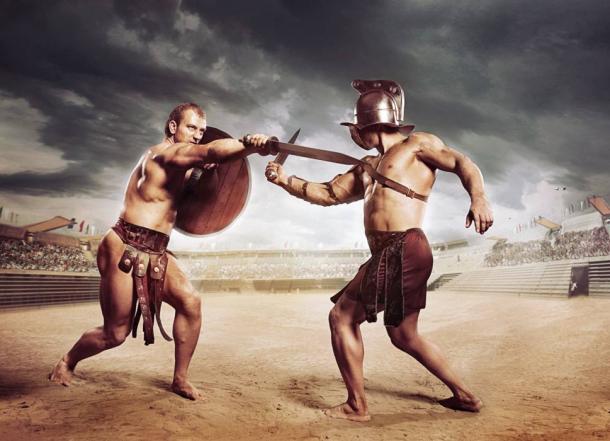
Roman gladiators fighting. (Fotokvadrat /Adobe Stock)
Roman Gladiators were both Slaves and Free Men
The tradition of gladiator fighting lasted for over 650 years – a proof of its popularity! Present throughout the Roman Empire, it was a fixture in the Roman entertainment calendar from 105 BC to 404 AD and the games remained largely unaltered bar a few small rule changes. Early on, most gladiators were condemned prisoners and slaves, who were sacrificed by their Emperors.
Later, when the Coliseum opened in 80 AD, being a gladiator proved a lucrative career move and thanks to this change, gladiator schools were set up to train volunteer fighters. The schools enticed free men with the hope of winning a stake of the prize money, and ultimately, glory. These new fighters included retired soldiers, warriors, and men desperate to make a living. Some were even knights and nobles who wanted to prove their pedigree and show off their fighting skills.
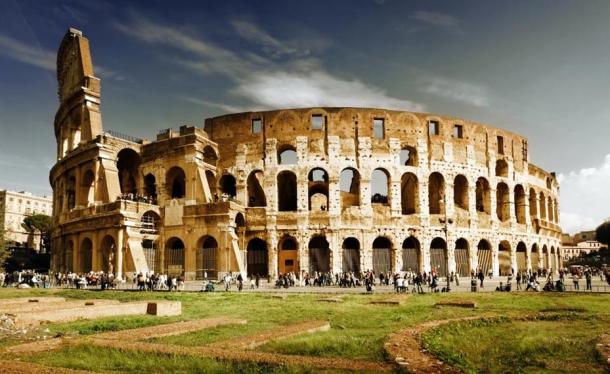
The Colosseum in Rome. Source: BigStockPhotos
Gladiators had their Own Training Schools
Rome had three notable training schools, including Capua, which was known for the caliber of gladiators it produced. Agents would scout for potential gladiators to try and persuade them to come and fight for their honor. These gladiator schools offered both safety and incarceration.
Comparable to a prison regime, they offered the comfort and security of three hearty meals a day and the best possible medical attention. However, the recruits, who were free men, had to live in shackles and were not allowed to speak at mealtimes.
They were allowed to keep any rewards and money if they won a fight. Their diet consisted of protein and carbohydrates, like barley porridge and cereals – with no option of wine, only water. Although the gladiators were fighting fit, most of them were a little on the round side. Extra ‘padding’ around the midsection was desirable, as it offered some protection against superficial sword wounds.
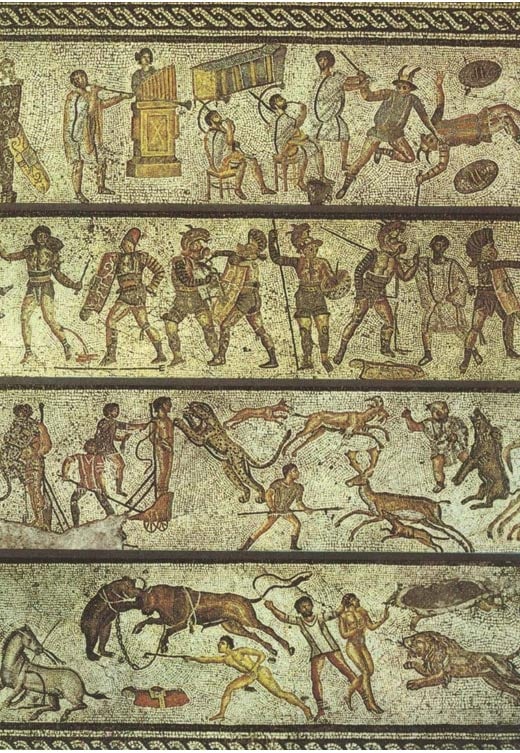
This mosaic depicts some of the entertainments that would have been offered at the games. Tripoli, Libya, first century. (Public Domain)
The Lifespan of a Roman Gladiator
Gladiators were an expensive investment for those who ran the gladiator schools, so it was preferable that the fighters did not die on the field – meaning they had to be strong enough to last more than one fight. Contrary to popular belief, not many gladiators actually fought to the death. Some historians say one in five died in battle, others one in ten, yet most only lived to their mid-twenties anyway – shocking when compared to today’s average!
However, it was also commonplace at fights held at the Coliseum for the Emperor to have the final say as to whether the combatants lived or died – often invoking the opinions of the audience to help decide the matter. So whether you fought well or not, your fate could lie ultimately in the hands of your ruler.
Female Gladiators also Existed
When we think of ancient Roman gladiators we tend to stereotype and think of men – warriors or slaves. But interestingly female slaves were also forced into the pit to fight alongside their male counterparts, or as Emperor Domitian preferred, to pit them against dwarves for his particular entertainment. Women fought in gladiator fights for 200 years, until Emperor Septimius Severus banned their participation from these bloodthirsty games.

Relief of two female gladiators (gladiatrices) found at Halicarnassus. (Public Domain)
Gladiator Weapons were Not ‘One Size Fits All’
The brave, strong Roman gladiators not only had their strength to bring into the pit but also their swords. The type of armor and weapons they fought with depended on their social ranking as a gladiator. There were four main classes of gladiator: the Samnite, Thracian, Myrmillo, and Retiarius.
The Samnites were equipped with a short sword (gladius), rectangular shield (scutum), greaves (ocrea), and a helmet. The Thracians fought with a curved short sword (sica) and a very small square or round shield (parma). The Myrmillo gladiators were nicknamed ‘fishmen’ as they wore a fish-shaped crest on their helmets and also carried a short sword and shield, like the Samnites, but their armor consisted only of padding on arm and leg. Finally, the Retiarius were the most exposed of all, with no helmet or armor other than a padded shoulder piece, and whose defense included a weighted net used to entangle the opponent, and a trident.
- Gladiator Helmets: Fit for Purpose, Not Just Protection
- Gladiators: Ancient Romans Loved Their Deadly Games
- The Gladiators Priscus and Verus: Equal they Fought, Equal they Yielded
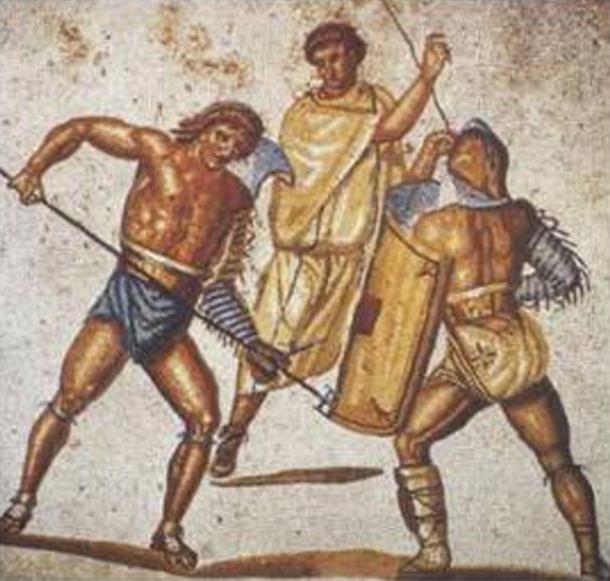
A retiarius stabs at a secutor with his trident in this mosaic from the villa at Nennig, Germany, c. 2nd–3rd century AD. (Public Domain)
The End of the Gladiator Games
Although Roman gladiators may have seemed well-equipped, the strength and courage it must have taken to step into battle and face death on a regular occurrence is unfathomable. We can be grateful that this brutal form of entertainment came to an end in 404 AD, thanks to the Emperor Honorius who closed down the gladiator schools. Who knows when this diversion might have ended had he not stepped in?
Learning that the majority of gladiators weren’t actually slaves, but free men who had volunteered for a slice of glory and winnings, makes gladiator fighting seem all the more bizarre and barbaric. Why choose a blood battle over traditional forms of trade and commerce?
However, it didn’t stop those who survived being venerated as heroes and legends of their time. But in the context of the 21st century, it’s safe to say that this is one sporting event we’re glad hasn’t come around again!
Top Image: An ancient Roman gladiator. Source: Luis Louro /Adobe Stock
By Fiona McCoss
Updated on September 25, 2020.
You can find out more about what life was really like in ancient Rome HERE, in the Webinar ‘Friends, Romans, Countrymen’ by Victor Labate


















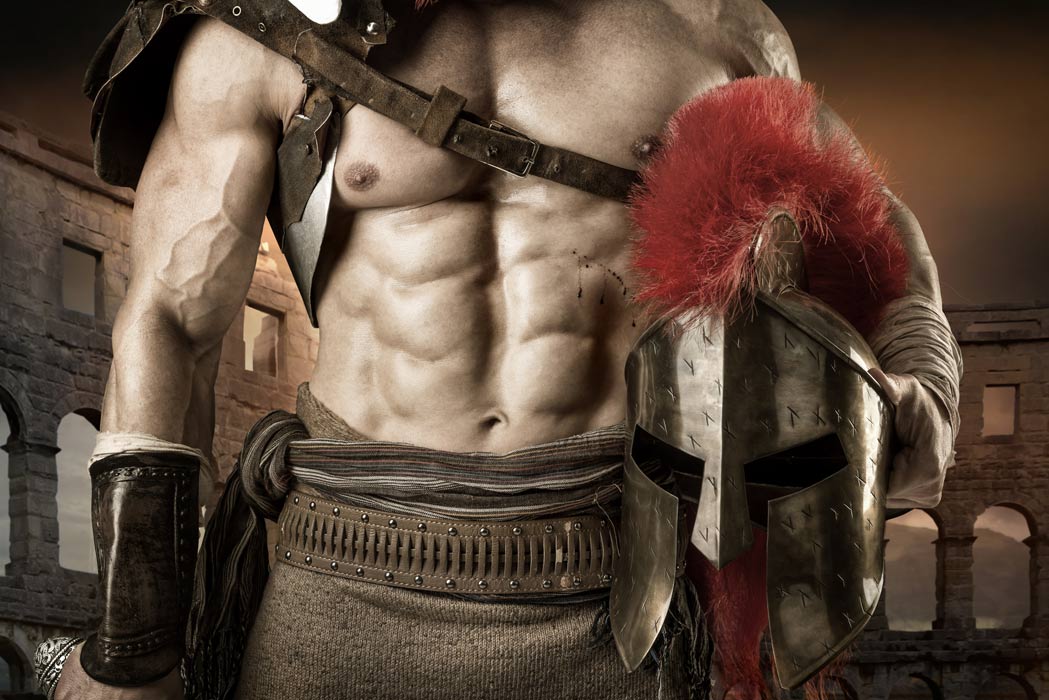

Comments
The content was good for breaking through common movie concepts of the gladiator, but I found this more than a bit jarring. "Learning that the majority of gladiators weren’t actually slaves, but free men who had volunteered for a slice of glory and winnings, makes gladiator fighting seem all the more bizarre and barbaric. Why choose a blood battle over traditional forms of trade and commerce?" Trade is barbarism that can't see its own damage. The reason is that men have an inborn desire to triumph over one another, and some are willing to do that "to the death". This is the real human species.
Are there gladiator schools for gorillas?
stop talking about killing get some candy
Today there is Daesh and car racing to fill the same function.
Congratulations to the author! Ms McCoss had done one of the most accurate and enjoyable articles on gladiators that I have ever read --- and I have read many. She breaks through the misconception that all the gladiators had to die, that they were all slaves, and that the emperors were all powerful.
Pages